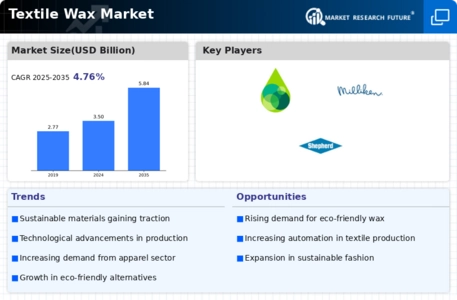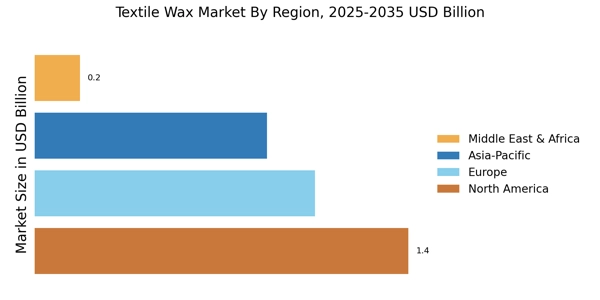Customization Trends
Customization is becoming a prominent driver in the Textile Wax Market. As brands seek to differentiate themselves, there is a growing demand for tailored wax solutions that meet specific customer needs. This trend is particularly evident in niche markets, where unique formulations can cater to specialized applications. The market for customized textile waxes is anticipated to expand significantly, with estimates suggesting a growth rate of 12% in the coming years. This shift towards customization not only enhances customer satisfaction but also encourages innovation within the Textile Wax Market, as manufacturers strive to develop bespoke products.
Regulatory Compliance
Regulatory compliance is a critical factor influencing the Textile Wax Market. Governments worldwide are implementing stringent regulations regarding the use of chemicals in textiles, prompting manufacturers to adapt their formulations. Compliance with these regulations not only ensures product safety but also enhances marketability. The market is likely to see a shift towards compliant wax products, which may lead to an increase in demand for certified textile waxes. This trend is expected to drive innovation as companies invest in research and development to create products that meet regulatory standards, thereby shaping the future of the Textile Wax Market.
Technological Innovations
Technological advancements play a pivotal role in shaping the Textile Wax Market. Innovations in production processes, such as the use of advanced extraction techniques, have improved the efficiency and quality of textile waxes. For instance, the introduction of nanotechnology in wax formulations has enhanced their performance characteristics, making them more effective in various applications. The market is expected to witness a compound annual growth rate of around 10% due to these technological improvements. Furthermore, automation in manufacturing processes is likely to reduce costs and increase production capacity, thereby benefiting the Textile Wax Market as a whole.
Sustainability Initiatives
The Textile Wax Market is increasingly influenced by sustainability initiatives. As consumers become more environmentally conscious, manufacturers are compelled to adopt eco-friendly practices. This shift is evident in the rising demand for natural waxes derived from renewable resources. In 2025, the market for sustainable textile wax is projected to grow by approximately 15%, reflecting a broader trend towards sustainable textiles. Companies that prioritize sustainability not only enhance their brand image but also meet regulatory requirements aimed at reducing environmental impact. This focus on sustainability is likely to drive innovation in the Textile Wax Market, leading to the development of new products that align with eco-friendly standards.
Rising Demand in Emerging Markets
Emerging markets are increasingly contributing to the growth of the Textile Wax Market. As economies develop, there is a surge in textile production, leading to higher demand for textile waxes. Countries in Asia and Africa are witnessing rapid industrialization, which is expected to drive the market forward. In 2025, it is projected that these regions will account for nearly 30% of the total textile wax consumption. This rising demand presents opportunities for manufacturers to expand their operations and cater to new markets, thereby enhancing their competitive edge in the Textile Wax Market.


















Leave a Comment